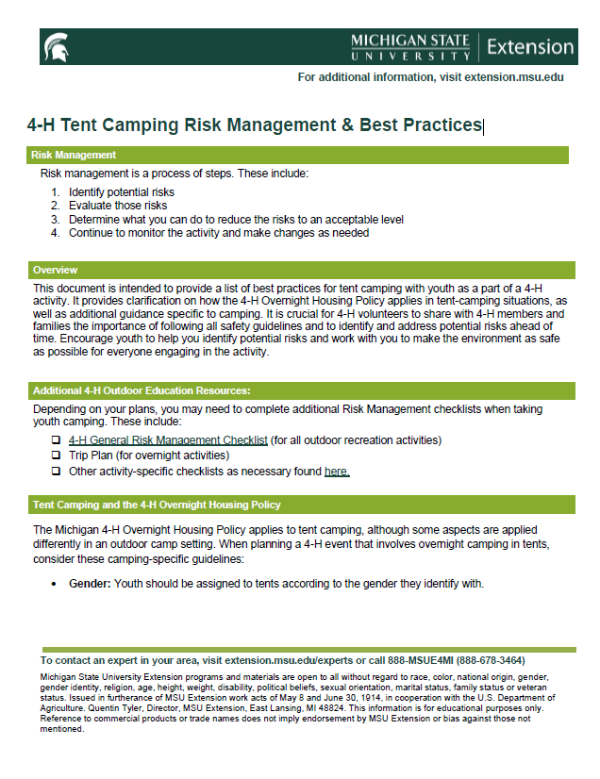
4-H Tent Camping Risk Management & Best Practices
DOWNLOADJune 3, 2025 - Michigan State University Extension
Risk Management
Risk management is a process of steps. These include:
1. Identify potential risks
2. Evaluate those risks
3. Determine what you can do to reduce the risks to an acceptable level
4. Continue to monitor the activity and make changes as needed
Overview
This document is intended to provide a list of best practices for tent camping with youth as a part of a 4-H activity. It provides clarification on how the 4-H Overnight Housing Policy applies in tent-camping situations, as well as additional guidance specific to camping. It is crucial for 4-H volunteers to share with 4-H members and families the importance of following all safety guidelines and to identify and address potential risks ahead of time. Encourage youth to help you identify potential risks and work with you to make the environment as safe as possible for everyone engaging in the activity.
Additional 4-H Outdoor Education Resources
Depending on your plans, you may need to complete additional Risk Management checklists when taking youth camping. These include:
❑ 4-H General Risk Management Checklist (for all outdoor recreation activities)
❑ Trip Plan (for overnight activities)
❑ Other activity-specific checklists as necessary found here.
Tent Camping and the 4-H Overnight Housing Policy
The Michigan 4-H Overnight Housing Policy applies to tent camping, although some aspects are applied differently in an outdoor camp setting. When planning a 4-H event that involves overnight camping in tents, consider these camping-specific guidelines:
• Gender: Youth should be assigned to tents according to the gender they identify with.
• Separate sleeping area: All youth must have their own sleeping bag. The number of youth in a tent should not exceed the tent’s capacity and, when possible, should remain below the full capacity (for example, a 3-person tent should ideally only sleep two youth).
• 4-H Member Ages: 18- and 19-year-old youth participants may be in tents with younger 4-H members with the written consent of a parent or legal guardian.
• Adults: Adult participants aged 20 or older will be in tents with other adult participants, or in their own tent. Adults will not share tents with a youth participant unless one of the few exceptions outlined in the Overnight Housing Policy applies and a written request for an exception is submitted to the appropriate staff person and approved.
• Bathrooms: In campgrounds where adequate separate bathrooms exist, adults will not use the same bathrooms as youth participants. In settings where limited facilities or a single bathroom or outhouse exist, steps will be taken to ensure that both youth and adults have privacy. If a single outhouse is available, a marker can be placed at the end of the trail when it is in use.
• The Overnight Housing Permission Form needs to be signed by parents/guardians of youth participants.
•Other policies that apply:
o Michigan 4-H Chaperone Training – any adults who attend a 4-H overnight camping trip must be GOLD level volunteers and must complete the Chaperone Module in Volunteer Central.
o Michigan 4-H Medication Administration Policy
Tent Camping Best Practices
In addition to the 4-H Overnight Housing Policy requirements, consider these best practices for safe tent camping:
Tent arrangements:
• One camper may be in a tent alone.
• Use a system to keep track of which youth are in which tent.
o Place a “tent tag” on each tent (similar to a hotel room number). Laminated numbers attached to the tent with a binder clip work well. Record camper names and tent numbers on a master list.
• Place tents so that visibility to the public is limited and public access can be monitored.
• Check the ground and area around the tent for debris and identify a level spot. Look up, down, and all around for potential hazards, including dead or dying trees overhead.
• Keep tent stakes and ropes away from walkways.
• Locate and communicate the nearest bathroom facility and how to access.
• Make sure campers know where adult chaperone tents are located and what to do if they are needed overnight.
Overnight Best Practices:
• Provide adequate light in the camping area by using landscape lights or ensuring that all participants have lanterns/flashlights accessible to them.
• Consider assigning staff or volunteers to monitor the camping area overnight in shifts.
• Have a plan for inclement weather and communicate it to campers. Include any nearby shelter that could be used and procedures to follow during a storm.
Support
Please reach out to the Outdoor Education and Risk Management Educators with any questions as you plan your camping experience. We are happy to help you plan an enjoyable, safe experience for your group.
For more information contact:
Joe Kreider
4-H Natural Resources and Outdoor Education
Kreider4@msu.edu
Dorothy Munn
Policy and Risk Management Educator
munnd@msu.edu



 Print
Print Email
Email